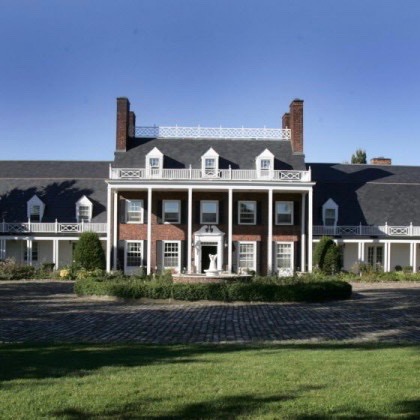HUNTING VALLEY — The village Planning Commission is poised to deny an application to convert the historic Roundwood Manor, a 55,000-square-foot residence within the Daisy Hill enclave, into six condominiums.
After nearly two hours of discussion on Tuesday morning, commission members said they likely would not support a variance of the village’s longstanding zoning requirement of one residence per 5 acres of land. The three members in attendance voted unanimously to have Law Director Stephen Byron draft conclusions of fact that would support denying the application.
Sylvia Korey, the owner of the manor and 7.69-acre property, several years ago proposed the idea of transforming the interior of her house into six individual condos to be sold as separate residential units. She has attempted to sell the home since 2002 and said the only interest she received was a prospective buyer who wanted to raze the mansion and build a new house on the land.
She said she came up with the condominium idea because the property has become too expensive to maintain and converting it would be an economically viable way to preserve its historic value. The home originally was built in the 1920s by Oris and Mantis Van Sweringen and last year was added to the Ohio Historic Inventory as a historic property in the state.
Ms. Korey’s team of attorneys, historic property experts and planning consultants have presented their case to the planning commission over the past several months as to why converting the property is feasible and appropriate. The village has also heard from people in opposition of the project including the attorney representing the Daisy Hill Homeowners Association, Sheldon Berns. Also speaking against the plan was George Smerigan, the village planning consultant who presented his report Tuesday.
Various topics were discussed Tuesday, with the most notable being how and if converting the property would be a detriment to neighboring property values.
Mr. Smerigan and Ms. Korey’s team, primarily attorney Anthony Coyne, butted heads during the meeting this week on how the transformation would impact the community.
Mr. Coyne argued that under the current zoning code, the planning commission has the discretion with a special use permit application – which is what is being requested – to allow any use within the U-1 residential district that does not create “substantial injury” to neighboring properties.
“It’s not changing the footprint of the structure,” he said. “The visual effect on the community is not going to change and frankly, the likely number of residents will be less than (the number) who have continually occupied the house over most of its existence.”
Ms. Korey said during the 30 years when she lived with her growing family, as many as 14 people occupied the house at one time.
“I have not heard any substantial injury to the adjacent properties, that you have any objective or subjective evidence to present to the commission,” Mr. Coyne said, directing his comment to Mr. Smerigan. “To let this property fall into disrepair, to sell it to somebody who wants to demolish it I think would be most unfortunate and I think it would be a real black eye to Hunting Valley if you let that happen.”
Mr. Smerigan said the key issue is in changing the density requirement.
“In my professional opinion, it’s not consistent or compatible with the single-family residential standard and the density standard,” he said. “In my opinion, it would have a detrimental impact on the values of the adjacent properties.”
He said to the commission that in allowing the increased density on the property “you’re essentially going to change the nature and character of the village. And I think you’re going to do it in a way that is going to adversely impact a fairly significant number of the property owners in the village.”
After each side was finished presenting their stance, the three commission members in attendance – Chris Nook, Councilman Jerry Medinger and Council President Bruce Mavec – adjourned to a brief executive session to discuss imminent litigation with counsel. After reconvening, all three members said they could not agree with increasing the zoning density.
“I’m very much in favor of historic preservation and I think it’s always an excellent thing to pursue,” Mr. Mavec said. “My only road block is the 5-acre density, which has been a sacrosanct part of the zoning code and I have yet to be convinced how that wouldn’t undermine or blow a hole in that by agreeing to do this under this current request.”
Mr. Medinger said, “I agree 100 percent with the concept of trying to foster preservation. But I’ve never been able to get myself comfortable trying to understand, if we were to accept this proposal, how it couldn’t negatively impact the 5-acre zoning. Until I’m convinced that’s not the case, I just can’t support the proposal as it’s been presented.”
The commission is expected to vote on the proposal at its April 10 meeting. There are six commission members and three votes are needed for approval. If her application is denied, Ms. Korey could appeal to the Cuyahoga County Common Pleas Court.



